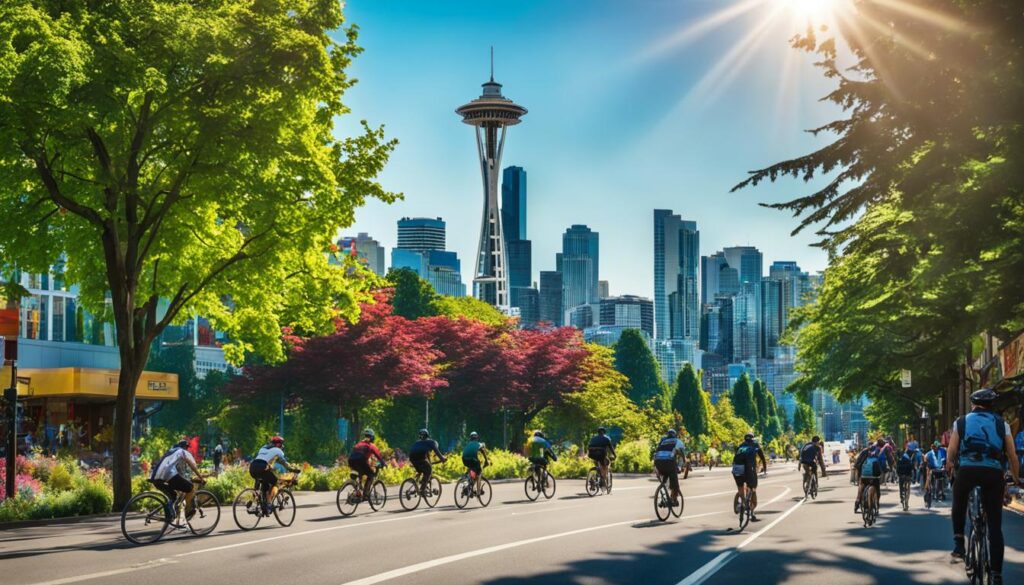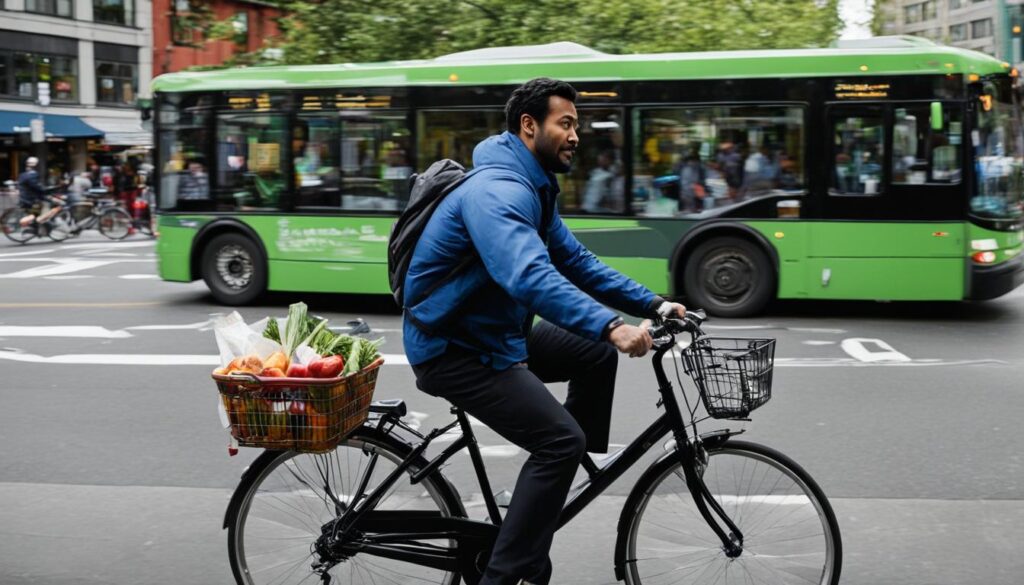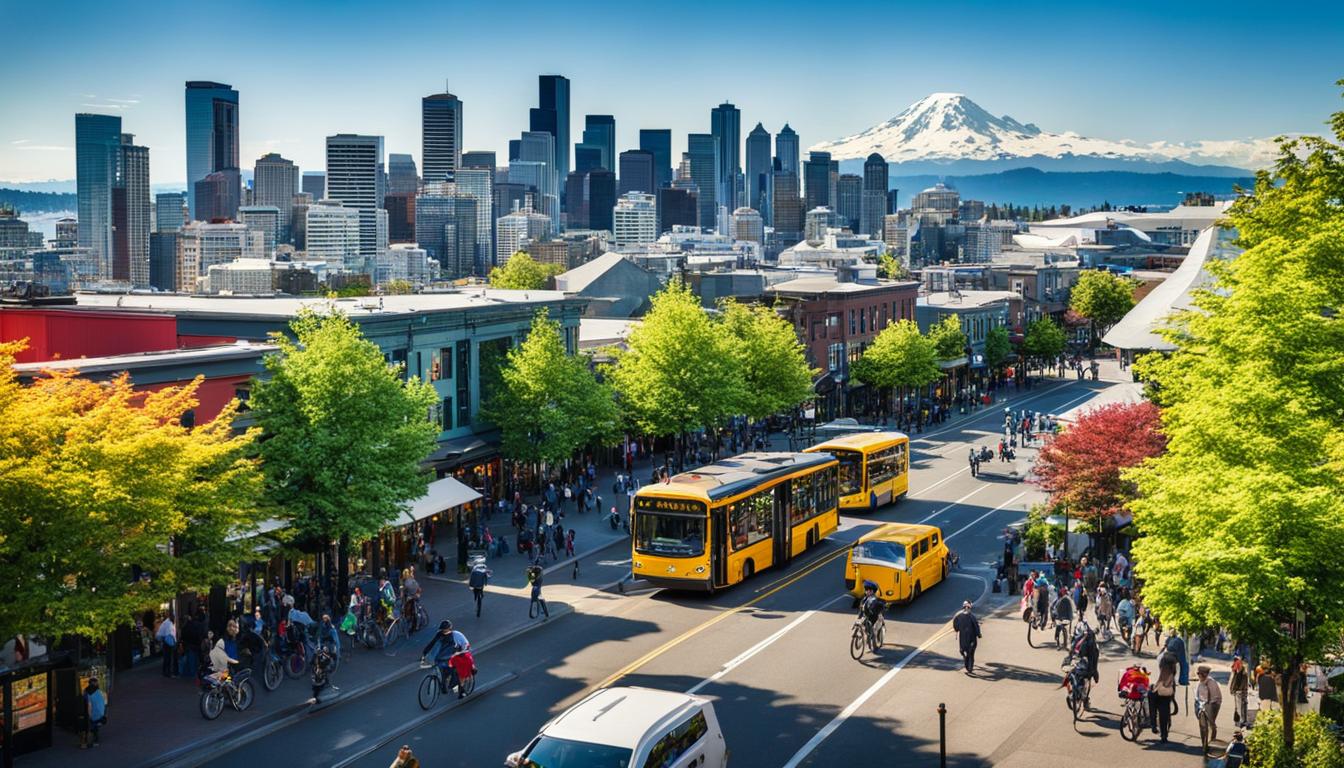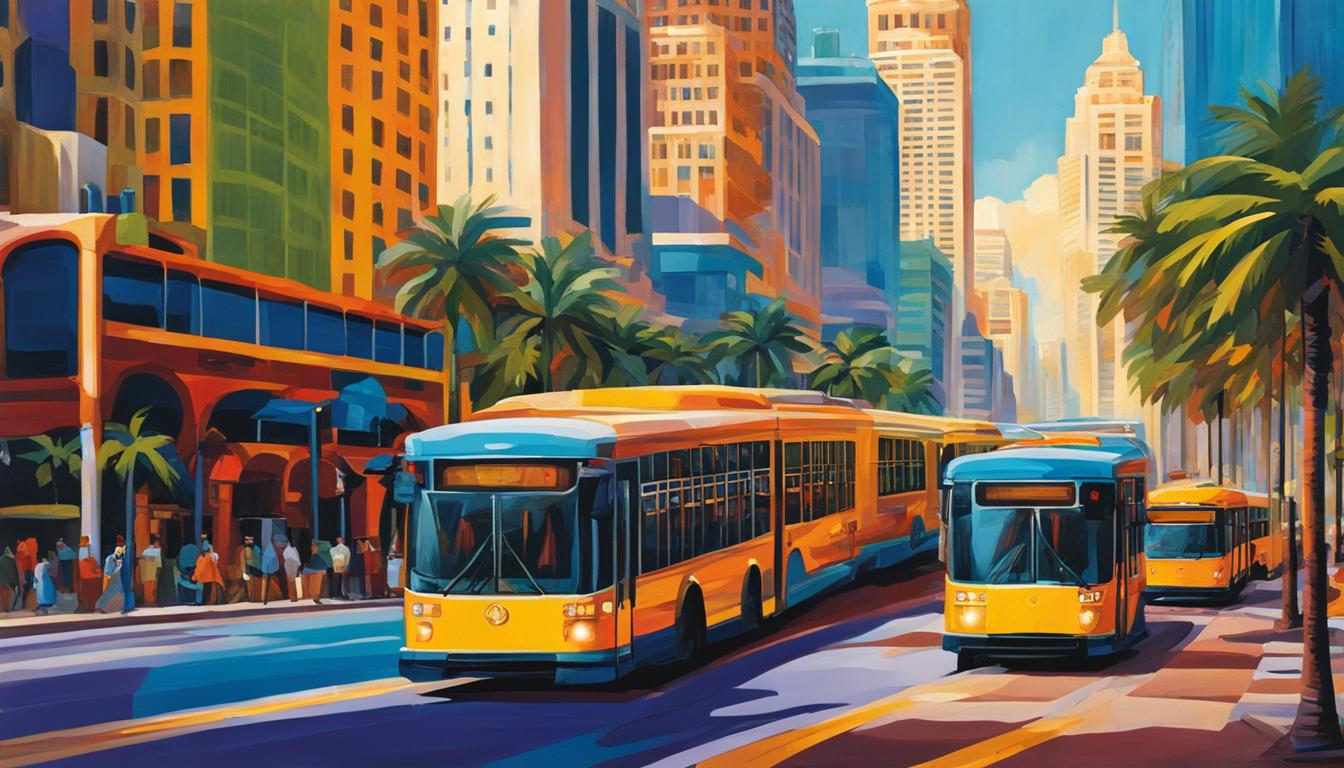Living in Seattle without a car is a viable option that offers a multitude of benefits. In this article, I will delve into the practicalities of car-free living in Seattle, exploring the city’s sustainable transportation options and alternatives. By embracing a car-free lifestyle, you can not only save money but also contribute to a healthier environment and foster a stronger sense of community engagement.
Seattle boasts a well-developed public transportation system, bike-friendly infrastructure, and pedestrian-friendly neighborhoods. Whether you choose to rely on buses, light rail, or ferries, or prefer biking or walking, Seattle provides a myriad of options to move around the city efficiently and sustainably.
Key Takeaways:
- Living car-free in Seattle is not only feasible but also offers numerous benefits.
- Seattle has a well-developed public transportation system, bike-friendly infrastructure, and pedestrian-friendly neighborhoods.
- Embracing a car-free lifestyle can lead to reduced expenses, improved health, decreased environmental impact, and a stronger sense of community engagement.
- Seattle offers several neighborhoods ideal for car-free living, including Capitol Hill, Downtown Seattle, Belltown, Fremont, Ballard, University District, and West Seattle.
- When choosing housing in Seattle without a car, consider the walkability of the neighborhood and proximity to essential services and public transportation hubs.
Understanding Seattle’s Public Transportation System
Seattle offers a well-developed public transportation system that includes buses, light rail, and ferries, providing residents and visitors with convenient options for getting around the city.
- Buses in Seattle: Metro Transit operates a comprehensive bus system that covers nearly every neighborhood in the city. With frequent service and extensive routes, buses are a reliable mode of transportation for daily commuting and city travel.
- Light rail in Seattle: The Link Light Rail connects Seattle’s southern neighborhoods to the University of Washington. Known for its punctuality, the light rail offers a comfortable and efficient way to travel within the city.
- Ferries in Seattle: Washington State Ferries operate several routes, connecting Seattle to various islands and nearby urban centers. Taking a ferry ride allows you to enjoy scenic views of the city while reaching your destination.
Whether you need to commute to work, explore different neighborhoods, or visit nearby attractions, Seattle’s public transportation system offers a wide reach and convenience. It is a cost-effective and sustainable alternative to driving, allowing you to navigate the city without the hassle of parking and traffic congestion.
Efficient and Reliable:
“Seattle’s public transportation system provides efficient and reliable service, ensuring timely arrivals and departures for commuters and travelers alike.”
Biking in Seattle
Seattle is renowned for its bike-friendly infrastructure and offers a plethora of opportunities for biking enthusiasts to explore the city. With well-established bike lanes and scenic biking trails, residents and visitors can enjoy safe and enjoyable cycling experiences. Biking in Seattle serves not only as a sustainable mode of transportation but also as a delightful recreational activity.
The city’s extensive network of bike lanes ensures that bikers have dedicated routes, separated from vehicle traffic, to navigate through the city. This bike-friendly infrastructure makes commuting by bike a convenient and efficient option for many individuals. Whether you’re cycling to work or exploring Seattle’s vibrant neighborhoods, you can rely on the well-designed bike lanes to guide your way.
Seattle is also known for its breathtaking biking trails that showcase the beauty of the city’s natural surroundings. From the famous Burke-Gilman Trail to the stunning Alki Beach Trail, there are numerous options for cyclists to enjoy scenic rides while immersing themselves in the stunning landscapes that Seattle has to offer. These trails provide an excellent opportunity for outdoor enthusiasts to experience the city’s natural beauty from a unique perspective.
“Biking is a fantastic way to experience the beauty of Seattle while promoting a healthy and sustainable lifestyle,” says Sarah Thompson, a Seattle resident and avid cyclist. “The bike lanes and trails make it easy and safe to navigate the city, and you get to enjoy stunning views along the way.”
To fully enjoy biking in Seattle, it is important to prioritize safety. Always wear a helmet and follow traffic rules to ensure a safe riding experience. Familiarize yourself with hand signals and be aware of your surroundings at all times. By prioritizing safety, you can make the most of your biking adventures while exploring the vibrant city of Seattle.

| Bike-Friendly Infrastructure in Seattle | Biking Trails in Seattle |
|---|---|
| – Well-established bike lanes throughout the city – Separate lanes for bikes, providing a safe riding experience – Bike racks and parking facilities available in various locations |
– Burke-Gilman Trail: A scenic trail stretching over 27 miles, passing through urban areas and lush green spaces – Alki Beach Trail: Offers stunning waterfront views of Puget Sound and the Seattle skyline – Chief Sealth Trail: Connects various neighborhoods and parks, showcasing Seattle’s natural beauty |
| – Bike-sharing programs for convenient access to bikes – Bike repair stations located throughout the city |
– Elliott Bay Trail: Follows the waterfront, providing picturesque views of the city and Elliott Bay – Interurban Trail: Spans over 14 miles, connecting Seattle to neighboring cities – Mercer Island Loop Trail: A scenic loop around Mercer Island, offering breathtaking views of Lake Washington |
Biking in Seattle offers not only a sustainable means of transportation but also a unique way to experience the city’s vibrant neighborhoods and scenic landscapes. Whether you’re a daily commuter or a weekend adventurer, you’ll find that biking in Seattle is a rewarding and enjoyable endeavor. So hop on your bike, explore the city, and embrace the beauty of Seattle on two wheels!
Walking in Seattle
Seattle is renowned for its walkable neighborhoods, providing residents with the convenience of strolling through pedestrian-friendly areas and easy access to essential amenities and services. These neighborhoods are designed with walkability in mind, boasting well-maintained sidewalks, crosswalks, and pedestrian-friendly facilities.
Living in a walkable neighborhood not only enhances the overall quality of life but also contributes to a healthier and more sustainable lifestyle. The abundance of walkable neighborhoods in Seattle reduces the dependence on constant car usage, encouraging residents to embrace walking as a primary mode of transportation and promoting physical activity.
Seattle’s commitment to walkability creates a vibrant and engaging cityscape, allowing individuals to fully experience and appreciate their surroundings. Walking in Seattle offers an opportunity to immerse oneself in the city’s unique culture, encounter local shops and restaurants, and engage with the community.
Pedestrian-Friendly Areas in Seattle
Seattle boasts numerous pedestrian-friendly areas that cater to the needs of both residents and visitors. The following are examples of neighborhoods with a strong emphasis on pedestrian infrastructure:
- Downtown Seattle: The heart of the city offers a pedestrian-friendly environment with a dense concentration of shops, restaurants, and attractions, all within walking distance.
- Capitol Hill: Known for its vibrant atmosphere, Capitol Hill features an extensive network of sidewalks and crosswalks, making it easy to explore the neighborhood by foot.
- Ballard: This waterfront neighborhood blends historic charm with modern amenities, providing residents with a walkable urban village experience.
- Fremont: With its quirky character and artistic spirit, Fremont offers walkable streets lined with eclectic shops, art installations, and a bustling Sunday Market.
Walkability in Seattle
Seattle is committed to enhancing walkability throughout the city, resulting in a high walkability score for many neighborhoods. These scores indicate the ease of navigating an area on foot and the proximity of essential services and public transportation hubs.
The Walk Score is a widely recognized measure of walkability, with a scale ranging from 0 to 100. Neighborhoods in Seattle consistently rank high on the Walk Score, showcasing the city’s dedication to creating pedestrian-friendly environments.
By prioritizing walkability, Seattle ensures that residents have the opportunity to enjoy a car-free lifestyle and embrace the numerous benefits that walking brings, from improved physical health to reduced carbon emissions.
Best Neighborhoods for Car-Free Living in Seattle
Seattle offers several neighborhoods that are ideal for car-free living. These neighborhoods have good access to public transportation, bike paths, and pedestrian-friendly streets, making it easy to get around without a personal vehicle.
Capitol Hill
Known for its vibrant atmosphere, Capitol Hill is one of Seattle’s most walkable neighborhoods. It offers a mix of residential, commercial, and entertainment options. The neighborhood is well-served by public transportation, including buses and light rail.
Downtown Seattle
Downtown Seattle is the heart of the city and provides easy access to a variety of amenities. With its bustling streets and numerous shops and restaurants, it is a walkable neighborhood that offers convenient access to public transportation options.
Belltown
Belltown is a neighborhood known for its lively nightlife, art scene, and proximity to downtown Seattle. It is a highly walkable neighborhood with easy access to public transportation, including buses and light rail.
Fremont
Fremont is a quirky and artistic neighborhood that offers a diverse range of shops, restaurants, and outdoor spaces. It is a walkable neighborhood with bike-friendly infrastructure and easy access to public transportation.
Ballard
Ballard is a trendy neighborhood known for its thriving food and drink scene, boutiques, and farmers market. It is a walkable neighborhood with well-maintained sidewalks, bike lanes, and easy access to public transportation.
University District
The University District is home to the University of Washington and offers a youthful and vibrant atmosphere. It is a walkable neighborhood with easy access to public transportation and a variety of amenities.
West Seattle
West Seattle is a relaxed and family-friendly neighborhood with beautiful views of downtown and the Puget Sound. It offers a range of shops, restaurants, and outdoor spaces that are easily accessible by foot or public transportation.
If you’re looking to embrace a car-free lifestyle in Seattle, these neighborhoods offer the convenience and walkability you need for a sustainable and enjoyable urban experience.
Choosing Housing Based on Walkability
When considering housing in Seattle for a car-free lifestyle, it is essential to prioritize the walkability of the neighborhood. Opting for a walkable neighborhood ensures easy access to essential services, grocery stores, schools, and public transportation hubs, eliminating the need for a personal vehicle. Choosing housing in a pedestrian-friendly area enhances the overall experience of car-free living and encourages a more sustainable lifestyle.
The Importance of Walkability
Walkability is a key factor in determining the convenience and accessibility of a neighborhood. A walkable neighborhood is characterized by the proximity of amenities and services, well-maintained sidewalks, and pedestrian-friendly infrastructure. Living in such a neighborhood allows residents to easily walk to nearby destinations, reducing the reliance on cars and promoting a healthier and more environmentally-friendly lifestyle.
When searching for walkable housing in Seattle, it is recommended to look for neighborhoods with high walkability scores. These scores are often provided by resources such as Walk Score or Walkonomics and indicate the overall walkability of an area. A high walkability score suggests that daily errands and activities can be accomplished on foot, making life more convenient for car-free individuals.
Benefits of Walkable Housing
Choosing housing in a walkable neighborhood offers several advantages for those living without a car. Here are some key benefits:
- Convenience: Walkable neighborhoods provide easy access to essential amenities like grocery stores, restaurants, cafes, and pharmacies. Running errands becomes effortless, saving time and reducing the need for car travel.
- Cost Savings: By eliminating the need for a personal vehicle, residents of walkable neighborhoods can save on the expenses associated with car ownership, such as fuel, insurance, parking fees, and maintenance.
- Health and Fitness: Living in a walkable neighborhood promotes a more active lifestyle, with daily walks becoming a regular part of the routine. Increased physical activity can improve cardiovascular health, reduce stress, and enhance overall well-being.
- Social Interaction: Walkable neighborhoods often foster a strong sense of community. The close proximity of neighbors and shared public spaces create opportunities for spontaneous interactions, fostering a sense of belonging and community engagement.
- Sustainability: Choosing housing in a walkable neighborhood aligns with sustainable living principles by reducing the carbon footprint associated with car travel. Walking is a zero-emission mode of transportation and contributes to a cleaner and greener environment.
Walkable Neighborhoods in Seattle
Seattle boasts numerous neighborhoods known for their walkability and pedestrian-friendly environments. Here are some examples:
| Neighborhood | Walkability Score (out of 100) | Notable Features |
|---|---|---|
| Capitol Hill | 98 | Eclectic mix of shops, restaurants, and nightlife |
| Belltown | 98 | Proximity to downtown Seattle and the waterfront |
| Fremont | 96 | Artistic vibe, weekly farmers market, and iconic Fremont Troll sculpture |
| Ballard | 93 | Historic neighborhood with a thriving dining and shopping scene |
These neighborhoods, along with many others in Seattle, offer a range of housing options for those looking to embrace a car-free lifestyle. Whether it’s apartments, townhouses, or single-family homes, there are numerous choices available in walkable and pedestrian-friendly areas.
Choosing housing based on walkability is a smart decision for those seeking a car-free lifestyle in Seattle. By prioritizing walkable neighborhoods, residents can enjoy the convenience, cost savings, health benefits, and community engagement that come with living without a car. It’s an opportunity to embrace sustainability, take advantage of urban amenities, and contribute to a vibrant and walkable city.
Car Sharing and Ride-Hailing Services in Seattle
When it comes to car-free transportation options in Seattle, there are several convenient and flexible solutions available. Car sharing and ride-hailing services have become increasingly popular among individuals who prefer to live without a personal vehicle. These services provide quick and easy access to transportation, allowing car-free individuals to bridge the gap between public transportation stops and their final destinations.
Zipcar and Car2Go are two well-known car-sharing services in Seattle. They offer the flexibility to rent a car by the hour or day, providing a cost-effective and convenient alternative to owning a car. With multiple locations throughout the city, it’s easy to find a car near you whenever you need one.
In addition to car sharing, Uber and Lyft are prominent ride-hailing services that operate in Seattle. These services connect users with drivers at the tap of a button, making it effortless to request a ride and reach your destination. Whether you’re heading to a meeting or exploring the city, ride-hailing services offer a reliable and efficient way to get around without a car.
“Car sharing and ride-hailing services provide convenient and flexible transportation options for car-free individuals.”
By utilizing these car-sharing and ride-hailing services in Seattle, car-free individuals can enjoy the benefits of personal transportation without the hassle and expense of owning a car. Whether you need a car for a few hours or a quick ride across town, these services are designed to cater to your specific transportation needs.
To further illustrate the benefits and features of the car-sharing and ride-hailing services in Seattle, refer to the table below:
| Service | Features |
|---|---|
| Zipcar | Fleet of vehicles available for hourly or daily rentals |
| Car2Go | One-way car rentals with flexible drop-off options |
| Uber | On-demand rides with a wide range of vehicle options |
| Lyft | Ridesharing with friendly drivers and affordable prices |
Bridging the Transportation Gap
Car sharing and ride-hailing services play a crucial role in complementing Seattle’s public transportation system. They provide an additional layer of convenience by allowing you to reach destinations that may not have direct access to buses or light rail stations. Whether it’s a last-mile connection or an urgent trip, these services ensure you can travel efficiently and comfortably.
With the availability of car sharing and ride-hailing services in Seattle, living car-free becomes even more feasible and practical. These convenient transportation options empower individuals to embrace a car-free lifestyle while still enjoying the convenience of personal transportation when needed.
Benefits of Living Without a Car
Living without a car in Seattle provides numerous benefits that go beyond reducing your carbon footprint. Embracing a car-free lifestyle can enhance your overall well-being and contribute to a more sustainable environment.
- Reduced Environmental Impact: Traveling by public transportation significantly reduces your carbon emissions and helps preserve the environment. By opting for buses, trains, and other modes of public transit, you contribute to a cleaner and greener Seattle.
- Convenience: Living car-free eliminates the stress and hassle of finding parking spaces. Instead, you can enjoy the convenience of hopping on a bus or train without worrying about parking fees or availability.
- Promotes Physical Activity: Walking to bus stops and between destinations naturally incorporates physical activity into your daily routine. This increased movement helps to improve fitness levels, boost energy, and promote overall well-being.
- Social Interactions: Commuting via public transportation provides opportunities for social interactions with fellow commuters. Whether it’s striking up a conversation or simply sharing a smile, these interactions can enhance your sense of community engagement and foster connections.
- Exploration and serendipitous encounters: Living without a car encourages exploration and discovering new places within the city. During your commute, you may stumble upon hidden gems, run into friends, or enjoy the ever-changing scenery that Seattle has to offer.
“Living without a car allows me to prioritize my wellbeing and reduce my impact on the environment. Each bus ride becomes an opportunity to connect with my community and appreciate the beauty of Seattle.”
Living car-free provides a multitude of benefits that extend beyond individual well-being. By adopting a car-free lifestyle, you contribute to a cleaner, more sustainable city and embrace the advantages of a thriving public transportation system. So why not join the growing number of Seattleites who are enjoying the perks of car-free living?

Practical Tips for Living Without a Car in Seattle
Living without a car in Seattle requires practical considerations. Here are some tips to help you navigate the city and make the most of your car-free lifestyle:
- Familiarize yourself with the public transportation system: Seattle has a well-developed public transportation network, including buses, light rail, and ferries. Take the time to understand the routes, schedules, and fare options. This knowledge will make your daily commute and city travel more efficient.
- Find a buddy: Having a friend or neighbor who is familiar with public transportation can be a valuable resource. They can provide guidance, answer questions, and even accompany you on your first few trips until you become more comfortable navigating the system.
- Have a backup with ride-hailing apps: While public transportation is reliable, there may be times when you need a backup option. Install ride-hailing apps like Uber or Lyft on your smartphone for those instances when you need a quick and convenient ride.
- Consider carpooling: If your work or daily activities involve traveling to similar destinations as others in your area, carpooling can be a cost-effective and eco-friendly option. Coordinate with coworkers, neighbors, or fellow commuters to share rides and reduce the number of vehicles on the road.
Living in an urban environment with a well-developed public transportation system enhances the feasibility of car-free living.
Embracing a car-free lifestyle in Seattle is both practical and rewarding. Take advantage of the city’s transportation alternatives and make the most of your carless living experience.
| Tips for Living Without a Car in Seattle | Benefits |
|---|---|
| Familiarize yourself with the public transportation system | Efficient and cost-effective travel |
| Find a buddy | Support and guidance in navigating the system |
| Have a backup with ride-hailing apps | Convenience and flexibility |
| Consider carpooling | Reduced environmental impact and cost sharing |
Choosing Car-Free Living in Other American Cities
Living a car-free lifestyle is not limited to Seattle. Several other American cities offer walkability and sustainable transportation options, making car-free living feasible and rewarding. Cities like Chicago, New York City, Boston, Portland, and Minneapolis have well-developed public transportation systems and pedestrian-friendly neighborhoods.
By choosing car-free living in these cities, individuals can enjoy similar benefits to those found in Seattle. They can save on transportation costs, reduce their carbon footprint, and experience the health benefits of walking and cycling. Embracing sustainable transportation options allows for a more environmentally conscious and active lifestyle.
Before making the decision to live car-free in another city, it’s important to research the specific public transportation system and the walkability of the neighborhoods. Understanding the availability and reliability of buses, trains, and bike lanes will help individuals plan their daily commutes and activities.
Awareness of the accessibility to amenities, such as grocery stores, schools, and healthcare facilities, within walking or biking distance is also essential. Evaluating these factors will enable individuals to make an informed choice that aligns with their preferences and routines.
Living car-free in cities across the United States offers a unique opportunity to embrace a sustainable and active lifestyle. Whether it’s in Seattle, Chicago, New York City, Boston, Portland, Minneapolis, or other cities with robust transportation systems, the benefits of car-free living are worth exploring.
Benefits of Car-Free Living in Selected American Cities
| City | Public Transportation | Walkability | Bike Infrastructure |
|---|---|---|---|
| Chicago | Extensive bus and train network operated by the Chicago Transit Authority (CTA) | Neighborhoods like Lincoln Park and Lakeview offer high walkability | Well-established bike lanes throughout the city |
| New York City | Extensive subway system operated by the Metropolitan Transportation Authority (MTA) | Most neighborhoods in Manhattan and Brooklyn are highly walkable | Bike lanes and Citi Bike sharing program available |
| Boston | Comprehensive subway system operated by the Massachusetts Bay Transportation Authority (MBTA) | Walkable neighborhoods like Beacon Hill and Back Bay | Bike lanes and Hubway bike sharing program available |
| Portland | Extensive bus and light rail network operated by TriMet | Highly walkable neighborhoods like Pearl District and Northwest District | Extensive bike lanes and BikeTown bike-sharing program available |
| Minneapolis | Excellent bus service and light rail system operated by Metro Transit | Neighborhoods like Downtown and Uptown offer walkability and amenities within reach | Comprehensive network of bike lanes and Nice Ride bike-sharing program available |
Considering Personal Circumstances for Car-Free Living
Deciding to live a car-free lifestyle is a personal choice that depends on individual circumstances and preferences. Before committing to a car-less lifestyle, it is important to consider several factors that can influence its feasibility and success.
Factors to Consider
- Proximity to Work: Evaluate the distance between your home and workplace. Living close to your workplace reduces the need for a car and makes commuting accessible through public transportation, biking, or walking.
- Availability of Public Transportation: Research the availability and reliability of public transportation in your area. Assess whether the public transit system covers your daily commute and other activities, such as grocery shopping, social events, or medical appointments.
- Walkability of the Neighborhood: Consider the walkability of your neighborhood. Look for well-maintained sidewalks, pedestrian-friendly infrastructure, and easy access to essential services such as grocery stores, schools, and parks.
- Tolerance for Inconveniences: Evaluate your tolerance for inconveniences, such as waiting for buses, potential delays, or crowded public transportation during peak hours. Some individuals may find the convenience of a car worth the associated expenses and challenges.
Each person’s experience with car-free living will vary based on their specific needs and preferences. Some individuals may find it easy and convenient to live without a car, while others may encounter challenges that make car ownership a better fit.
Remember, there is no one-size-fits-all solution. Consider your personal circumstances and weigh the benefits and drawbacks of car-free living before making a decision.
By carefully evaluating your personal circumstances, you can determine whether car-free living is feasible and aligns with your lifestyle goals. Keep in mind that personal circumstances may change over time, which can influence the feasibility of a car-less lifestyle.

Conclusion
Wrapping up car-free living in Seattle, it is evident that this lifestyle choice is not only feasible but also comes with a multitude of benefits. Seattle’s well-developed public transportation system, bike-friendly infrastructure, and walkable neighborhoods make it a city that encourages and supports sustainable living without the need for a personal vehicle.
By embracing a car-free lifestyle in Seattle, individuals can experience reduced expenses, improved health, and a decreased environmental impact. With options like buses, light rail, and ferries, getting around the city is convenient and efficient. Additionally, biking and walking are not only excellent modes of transportation but also offer enjoyable recreational opportunities.
Living car-free in Seattle also fosters a stronger sense of community engagement. Interacting with fellow commuters and exploring the city on foot or by bike allows for social connections and a greater appreciation of the neighborhood. Whether in Seattle or other walkable cities, considering a car-free lifestyle can lead to a more sustainable and fulfilling way of living.
FAQ
Is it possible to live in Seattle without a car?
Yes, it is definitely possible to live in Seattle without a car. The city has a well-developed public transportation system, bike-friendly infrastructure, and walkable neighborhoods that make car-free living feasible and convenient.
What is the public transportation system like in Seattle?
Seattle’s public transportation system consists of buses, light rail, and ferries. Metro Transit operates a comprehensive bus system that covers nearly every neighborhood in the city. The Link Light Rail connects the city’s southern neighborhoods to the University of Washington and is known for its punctuality. Washington State Ferries operate several routes, connecting Seattle to various islands and nearby urban centers.
Are there bike-friendly options in Seattle?
Absolutely! Seattle offers a bike-friendly infrastructure with well-established bike lanes and scenic biking trails. The city’s extensive network of bike lanes ensures safe and enjoyable cycling for commuters and enthusiasts.
Are there walkable neighborhoods in Seattle?
Yes, Seattle takes pride in its walkable neighborhoods, which offer residents the convenience of strolling through pedestrian-friendly areas and easy access to amenities and services. Living in a walkable neighborhood enhances the overall quality of life by reducing the need for constant car usage and promoting a healthier and more sustainable lifestyle.
Which neighborhoods in Seattle are ideal for car-free living?
Capitol Hill, Downtown Seattle, Belltown, Fremont, Ballard, University District, and West Seattle are among the best neighborhoods for those looking to live without a car. These neighborhoods have good access to public transportation, bike paths, and pedestrian-friendly streets, making it easy to get around without a personal vehicle.
What should I consider when choosing housing for car-free living in Seattle?
When searching for housing in Seattle without a car, it is important to consider the walkability of the neighborhood. Look for neighborhoods with high walkability scores, indicating that essential services, grocery stores, schools, and public transportation hubs are within walking distance. Choosing housing in a walkable neighborhood enhances the overall car-free living experience and promotes a more sustainable lifestyle.
Are there car-sharing and ride-hailing services in Seattle?
Yes, Seattle offers car-sharing and ride-hailing services that provide convenient and flexible transportation options for car-free individuals. Zipcar, Car2Go, Uber, and Lyft are popular choices for getting around the city. These services can bridge the gap between public transportation stops and final destinations.
What are the benefits of living without a car in Seattle?
Living without a car in Seattle offers various benefits beyond reducing carbon footprint. It can lead to reduced expenses, improved health, decreased environmental impact, and a stronger sense of community engagement. Traveling by public transportation promotes physical activity and allows for social interactions with fellow commuters.
What practical tips can help me live without a car in Seattle?
To live without a car in Seattle, it is advisable to familiarize yourself with the public transportation system, find a buddy who knows it well or is willing to learn with you, and have ride-hailing apps like Uber or Lyft for backup. Carpooling with others for commutes can also be an option. Living in an urban environment with a well-developed public transportation system enhances the feasibility of car-free living.
Is car-free living feasible in other American cities?
Yes, other American cities like Chicago, New York City, Boston, Portland, and Minneapolis are known for their walkability and public transportation systems. Living car-free in these cities provides similar benefits and allows individuals to rely on sustainable transportation options.
What factors should I consider for car-free living based on personal circumstances?
Whether car-free living is feasible depends on personal circumstances and preferences. Factors such as proximity to work, availability of public transportation, walkability of the neighborhood, and tolerance for inconveniences associated with bus travel should be considered. Each individual’s experience of car-free living will vary based on their specific needs and preferences.


